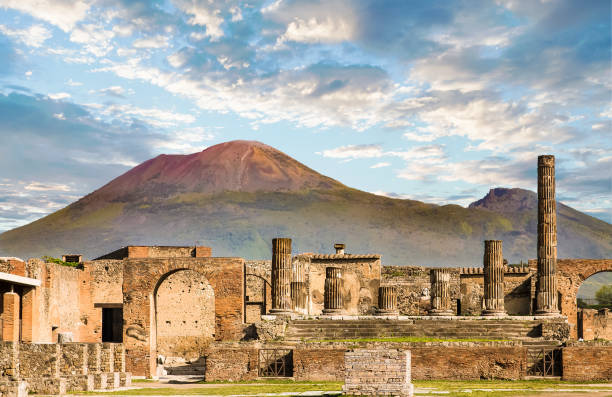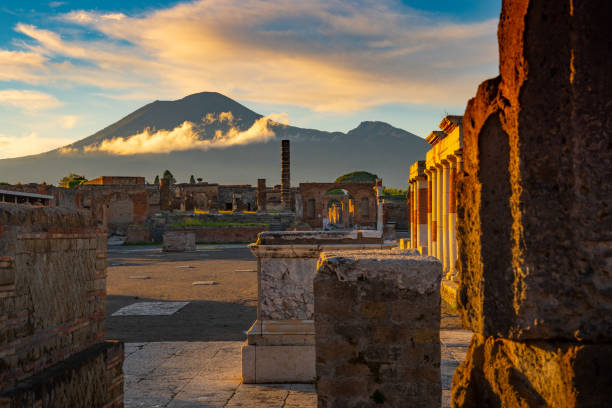Pompeii Archaeological Park: A Window into Ancient Roman Life Frozen in Time
Buried under meters of volcanic ash and pumice during the catastrophic eruption of Mount Vesuvius in 79 AD, the ancient city of Pompeii remained lost to the world for nearly 1,700 years until its accidental rediscovery in 1748. Today, the Pompeii Archaeological Park stands as one of the most significant and best-preserved archaeological sites in the world, offering an unparalleled glimpse into daily life in a Roman city at the height of the Empire.

Designated a UNESCO World Heritage Site in 1997, it attracts nearly 4 million visitors annually, who come to walk its ancient streets, marvel at its remarkably preserved buildings, and confront the haunting plaster casts of eruption victims. Spanning 170 acres, the park serves as an extraordinary time capsule of Roman urban planning, architecture, art, and social history—continuing to yield new discoveries even after nearly three centuries of excavation.

The Historical Context of Pompeii Before the Eruption
Pompeii's story begins long before its famous destruction. Founded by the Oscans in the 6th or 7th century BC, the city came under Greek and later Etruscan influence before becoming a Roman colony in 80 BC. By the 1st century AD, Pompeii had developed into a thriving commercial center and resort town with a population estimated between 11,000 and 15,000 inhabitants. Its strategic location near the Bay of Naples and fertile volcanic soil made it prosperous through agriculture, fishing, and trade. The city boasted all the amenities of Roman urban life: temples, theaters, baths, a forum, an amphitheater, and numerous shops and taverns. Wealthy patricians built lavish villas decorated with exquisite frescoes and mosaics, while the middle class lived in modest townhouses, and slaves occupied cramped quarters behind workshops. This vibrant society was abruptly terminated on August 24 (or possibly October 24), 79 AD, when Mount Vesuvius unleashed one of history's most devastating volcanic eruptions, burying Pompeii and neighboring Herculaneum under layers of ash and pyroclastic material.
The Rediscovery and Early Excavation of Pompeii
The site's modern history began in 1748 when Spanish engineer Rocque Joaquin de Alcubierre, working for the Bourbon King Charles III, discovered the first remains while digging an aqueduct. These early excavations were essentially treasure hunts, with little regard for scientific method or preservation. Workers tunneled through the compacted ash to remove valuable artifacts, sculptures, and mosaics for the royal collections, often damaging structures in the process. The famous House of the Faun, containing the magnificent Alexander Mosaic, was looted in this fashion. A shift toward more systematic archaeology began in 1860 under Giuseppe Fiorelli, who introduced revolutionary techniques including plaster casting of voids left by decomposed organic material (revealing the haunting human figures Pompeii is famous for) and a numbering system for buildings that is still used today. Fiorelli also divided the city into regions (regiones) and blocks (insulae) to better organize study of the urban layout. Subsequent directors of excavations, including Vittorio Spinazzola and Amedeo Maiuri in the 20th century, focused on reconstructing buildings to their full height and studying the city's development over time rather than simply uncovering more area.
The Layout and Urban Planning of Ancient Pompeii
Walking through Pompeii today, visitors can appreciate the sophisticated urban planning of a Roman provincial city. The irregular oval shape of Pompeii's city walls encloses approximately 170 acres, with a street grid that reflects both Greek influence and organic growth over centuries. The main thoroughfare, Via dell'Abbondanza, runs east-west from the Forum to the amphitheater, lined with shops, taverns, and homes that give a vivid sense of daily commerce. The streets feature raised sidewalks and stepping stones to keep pedestrians above rainwater and waste, while deep ruts worn by cart wheels testify to centuries of use. The Forum served as the civic and religious heart of Pompeii, surrounded by temples to Jupiter, Apollo, and other deities, as well as government buildings like the Basilica (law courts) and the Macellum (market). Public water fountains at street intersections connected to an aqueduct system brought fresh water from the mountains, while an underground sewer system handled waste. The city's entertainment needs were met by two theaters (one large, one small), an amphitheater that could seat 20,000 spectators (the oldest surviving Roman amphitheater), and numerous bath complexes that served as social hubs. Residential areas reveal stark social stratification, from the opulent Villa of the Mysteries with its famous fresco cycle to modest apartments above shops.

Remarkable Architectural Features and Artistic Treasures
Pompeii's buildings preserve an extraordinary range of Roman architectural styles and decorative arts. The volcanic ash acted as a preservative, protecting wall paintings, mosaics, and even wooden elements from normal decay. The city's homes showcase the typical Roman domus layout centered around an atrium (reception hall) and peristyle garden, with rooms arranged to ensure privacy while displaying the owner's wealth and taste. Frescoes follow the four Pompeian styles identified by archaeologist August Mau: from the faux-marble panels of the First Style (2nd century BC) to the elaborate architectural fantasies of the Second Style, the delicate ornamental Third Style, and the crowded mythological scenes of the Fourth Style (contemporary with the eruption). Notable examples include the Dionysiac frieze in the Villa of the Mysteries, the Alexander Mosaic depicting the Battle of Issus, and the erotic art in the Suburban Baths that was kept locked away in the "Secret Cabinet" of Naples' Archaeological Museum for centuries. Public buildings feature innovative Roman engineering like the barrel-vaulted changing rooms in the Stabian Baths and the clever use of brick-faced concrete in the amphitheater. Even graffiti survives, offering direct voices from the past—political slogans, gladiator fan messages, and personal declarations like "Celadus the Thracian makes all the girls sigh."
The Tragic Human Story: Plaster Casts and Forensic Archaeology
Perhaps Pompeii's most emotionally powerful remains are the plaster casts of victims, created by pouring plaster into voids left by decomposed bodies in the volcanic ash. Giuseppe Fiorelli developed this technique in 1863, revealing not just skeletal remains but the final postures and even facial expressions of people caught in the disaster. Some casts show victims covering their mouths against the toxic gases, while others appear to be sleeping. A pregnant woman lies curled on her side; a group of thirteen people perished huddled together in a garden; a man sits with his knees drawn up, head in hands. Recent CT scans of these casts have provided new forensic details about the victims' health, diet, and causes of death. The "Garden of the Fugitives" contains the largest group of casts—thirteen adults and children who died together trying to escape. Modern research suggests most victims didn't die from lava or ash burial, but from extreme heat (300°C/570°F) from pyroclastic flows that caused instant vaporization of soft tissue and lethal shock. These haunting figures transform Pompeii from an archaeological site into a profoundly human tragedy, connecting us viscerally with individuals whose lives ended suddenly nearly two millennia ago.
Ongoing Excavations and New Discoveries
Contrary to popular belief, only about two-thirds of Pompeii has been excavated, and new discoveries continue to reshape our understanding of the city. Recent major finds include:
The 2018 discovery of a vivid fresco depicting the mythological hunter Narcissus
The 2020 unearthing of a thermopolium (Roman fast-food counter) with still-visible food remains
The 2021 excavation of a ceremonial chariot near the villa at Civita Giuliana
The 2023 discovery of a slave's room containing beds, a chamber pot, and other personal items
Advanced technologies like 3D laser scanning, drone photography, and chemical analysis are being employed to study the site with less invasive methods. The Great Pompeii Project, funded by the European Union, has focused on conservation of already-excavated areas rather than new digs, stabilizing fragile structures against further decay from weathering, vegetation, and tourism. This represents a shift in archaeological philosophy from rapid uncovering to careful preservation for future study with better technologies. Excavations in the unburied Regio V section have revealed previously unknown buildings and artworks while employing modern stratigraphic methods to document each layer of volcanic deposition.
Conservation Challenges and Tourism Management
Preserving Pompeii presents enormous challenges. Exposure to the elements after excavation has caused deterioration of frescoes and structures that survived intact for centuries under the ash. Poor restoration attempts in the past used inappropriate materials like Portland cement that damaged original surfaces. The site suffers from inadequate drainage, invasive vegetation, and the sheer pressure of millions of visitors annually. Major collapses in 2010 (the Schola Armaturarum) sparked international concern and led to increased funding for conservation. Current efforts focus on:
Climate-controlled shelters for fragile frescoes
Laser cleaning of encrusted surfaces
Reinforcing structures with fiberglass rods instead of metal
Limiting visitor numbers in sensitive areas
Creating detailed digital records of the entire site
The management balances accessibility with preservation, offering night tours and virtual reality experiences to disperse crowds while closing some areas for restoration. A new "Pompeii Commitment" initiative aims to make the park carbon-neutral through solar panels and electric shuttles.
Pompeii's Cultural Legacy and Influence
Beyond its archaeological importance, Pompeii has profoundly influenced Western culture since its rediscovery. The 18th-century excavations coincided with the rise of Neoclassicism, making Pompeian motifs fashionable in architecture (Adam style), decorative arts (Wedgwood pottery), and even garden design. Literary figures from Goethe to Bulwer-Lytton to Robert Harris have been inspired by the tragedy. Modern popular culture references abound, from Pink Floyd's 1971 live performance among the ruins to the numerous disaster films about Vesuvius. Psychologically, Pompeii serves as a memento mori—a reminder of civilization's fragility that resonates particularly in eras of environmental anxiety. Academically, the site remains indispensable for studying Roman technology, urbanism, art history, and social structures, with ongoing research projects across multiple disciplines. The plaster casts in particular have transformed how we conceptualize the past, making ancient Romans viscerally present in ways that artifacts alone cannot achieve.
Visiting Pompeii Today: A Transformative Experience
For modern visitors, Pompeii offers an unparalleled opportunity to walk through an entire ancient city frozen at a single moment in time. Unlike Rome's fragmentary ruins, Pompeii presents complete city blocks where one can trace the routines of daily life—from bakeries with petrified loaves still in their ovens to tavern counters with serving holes for hot food. The scale of preservation allows visitors to experience the city as the ancients did, noting how sunlight enters atrium skylights or how fountains once sounded in courtyards. Key highlights include:
The Forum with its temples and municipal buildings
The Lupanar (brothel) with its erotic frescoes
The House of the Vettii with its well-preserved paintings
The Stabian Baths showing Roman hygiene practices
The Amphitheater where gladiators fought
The Villa of the Mysteries with its enigmatic fresco cycle
Guided tours can illuminate subtle details like bakery advertisements painted on walls or election notices scrawled in charcoal. The nearby Antiquarium museum displays artifacts too fragile to leave in situ, while the modern town of Pompei offers accommodations for those wishing to spend multiple days exploring.
Conclusion: Pompeii's Enduring Significance
More than just an archaeological site, Pompeii stands as a monument to both human achievement and nature's destructive power. Its extraordinary preservation provides an unmatched resource for understanding Roman civilization while serving as a poignant reminder of life's fragility. The ongoing work at the site—balancing excavation, conservation, and public access—ensures that Pompeii will continue to yield new insights for generations to come. As climate change and political instability threaten cultural heritage worldwide, Pompeii's careful management sets important precedents for protecting our shared past. For scholars, it remains an indispensable laboratory for the ancient world; for visitors, a profoundly moving encounter with history; and for humanity collectively, a powerful symbol of civilization's ephemeral nature against geological time. The silent streets where Romans once hurried about their business now speak volumes about the universality of human hopes, fears, and daily struggles across two millennia.
Photo from iStock and Depositphotos
0 Comment to "Pompeii Archaeological Park: A Preserved Roman City Frozen in Time by Vesuvius' Eruption"
Post a Comment